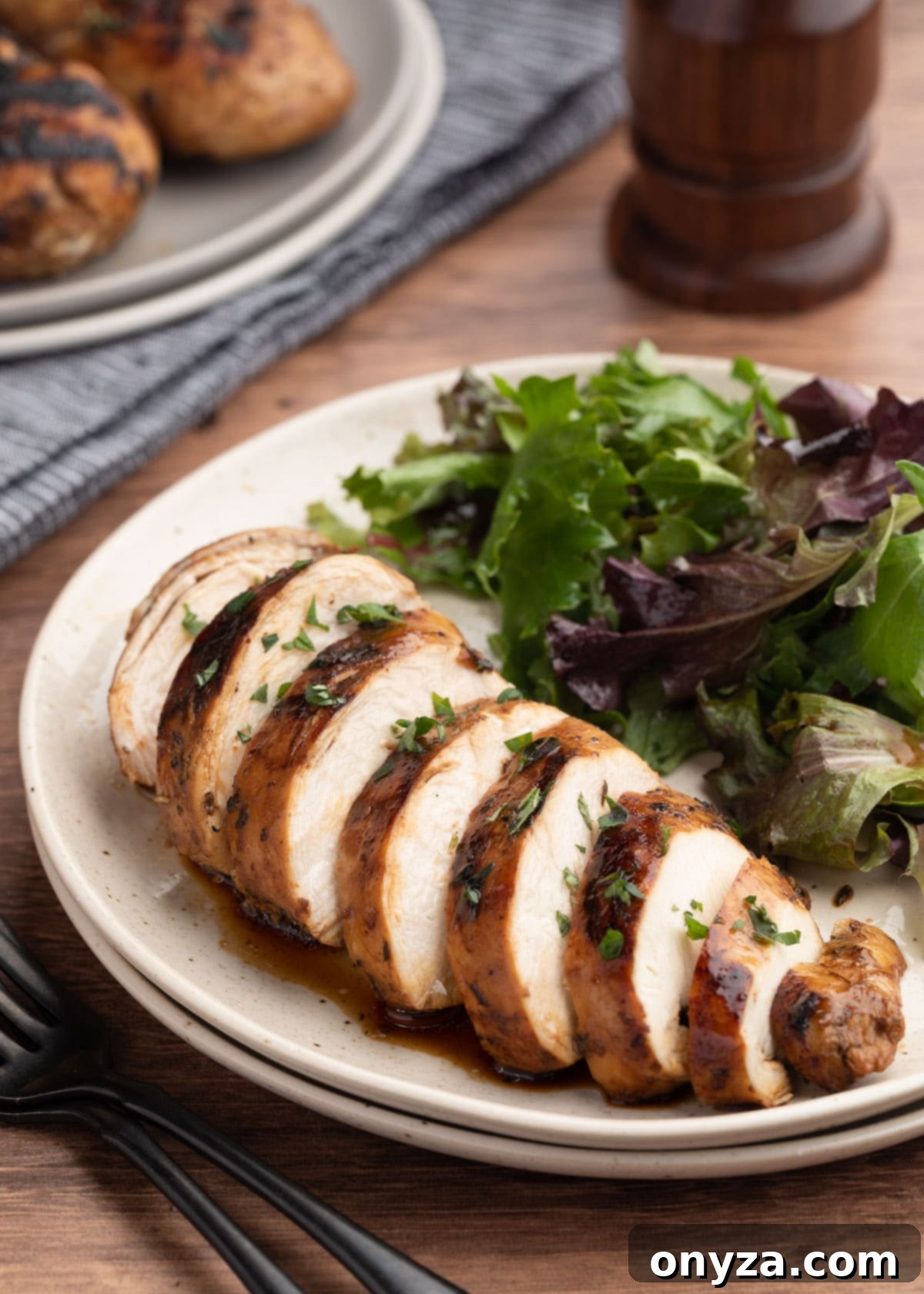Tired of bland, uninspired chicken dinners? It’s time to transform your weeknight meals with this incredibly juicy and intensely flavorful Balsamic Marinated Chicken. This recipe is designed for ease and convenience, making it perfect for busy schedules while still delivering a gourmet taste. Whether you’re meal prepping for the week ahead or looking for an impressive main course, this versatile balsamic chicken recipe adapts perfectly to grilling, baking, or air frying, ensuring a delicious result every time. Say goodbye to dry chicken and hello to a culinary experience that will delight your taste buds!
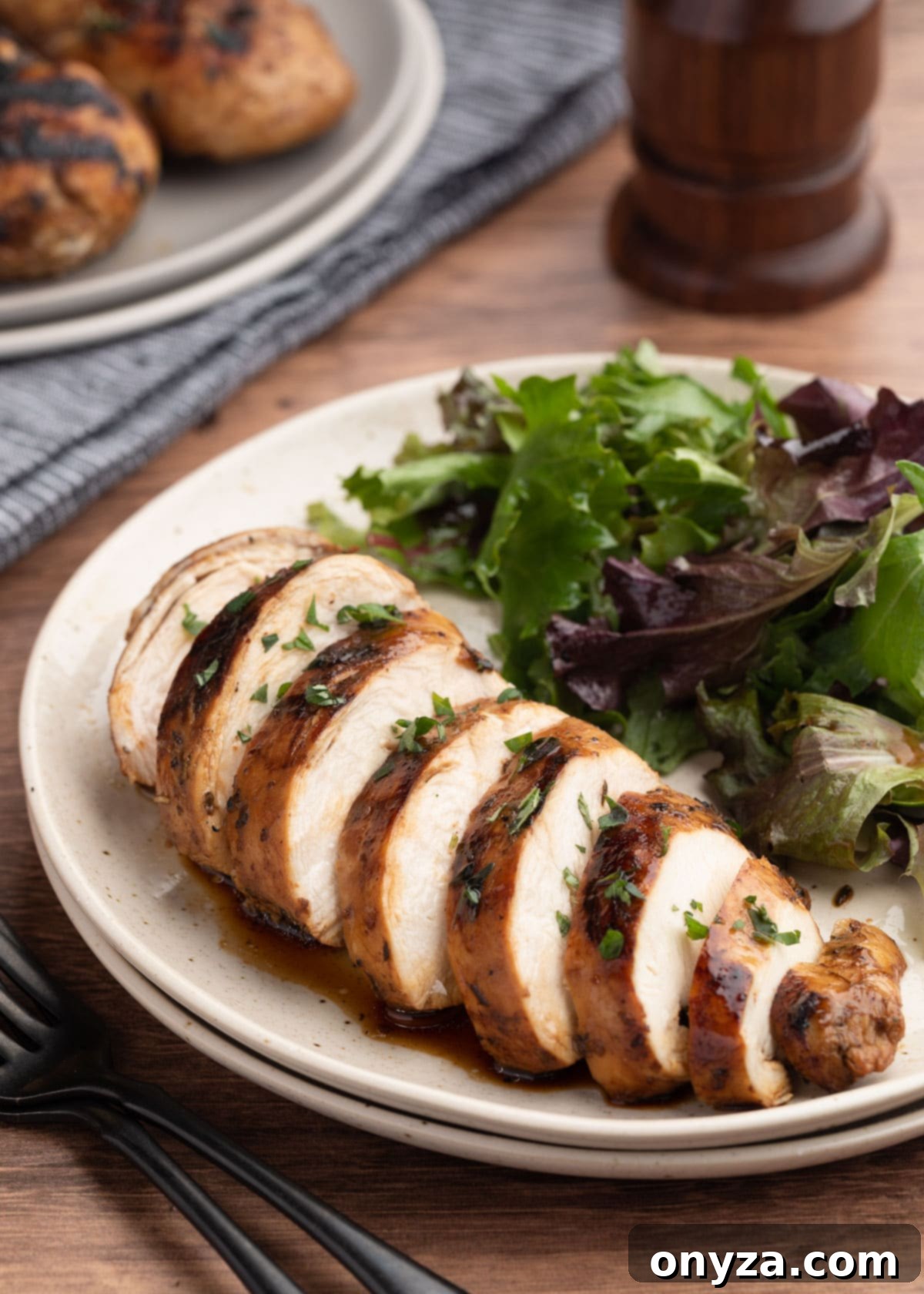
Many home cooks often ask for simple, healthy, and exciting ways to prepare chicken. My go-to answer, especially for boneless, skinless chicken breasts, is always this incredible Balsamic Chicken Marinade. This marinade isn’t just about adding flavor; it’s a secret weapon for achieving perfectly tender and succulent chicken that’s never boring.
The beauty of marinating chicken lies in its simplicity and efficiency. It infuses your chicken with deep, complex flavors, and the best part is how little active time it requires. You’ll only need about 5 minutes to whisk together this simple yet potent balsamic marinade. After that, the magic happens passively in your refrigerator, leaving you with more free time until you’re ready to cook dinner or prepare your meals for the week. This makes it an ideal solution for modern, busy lifestyles.
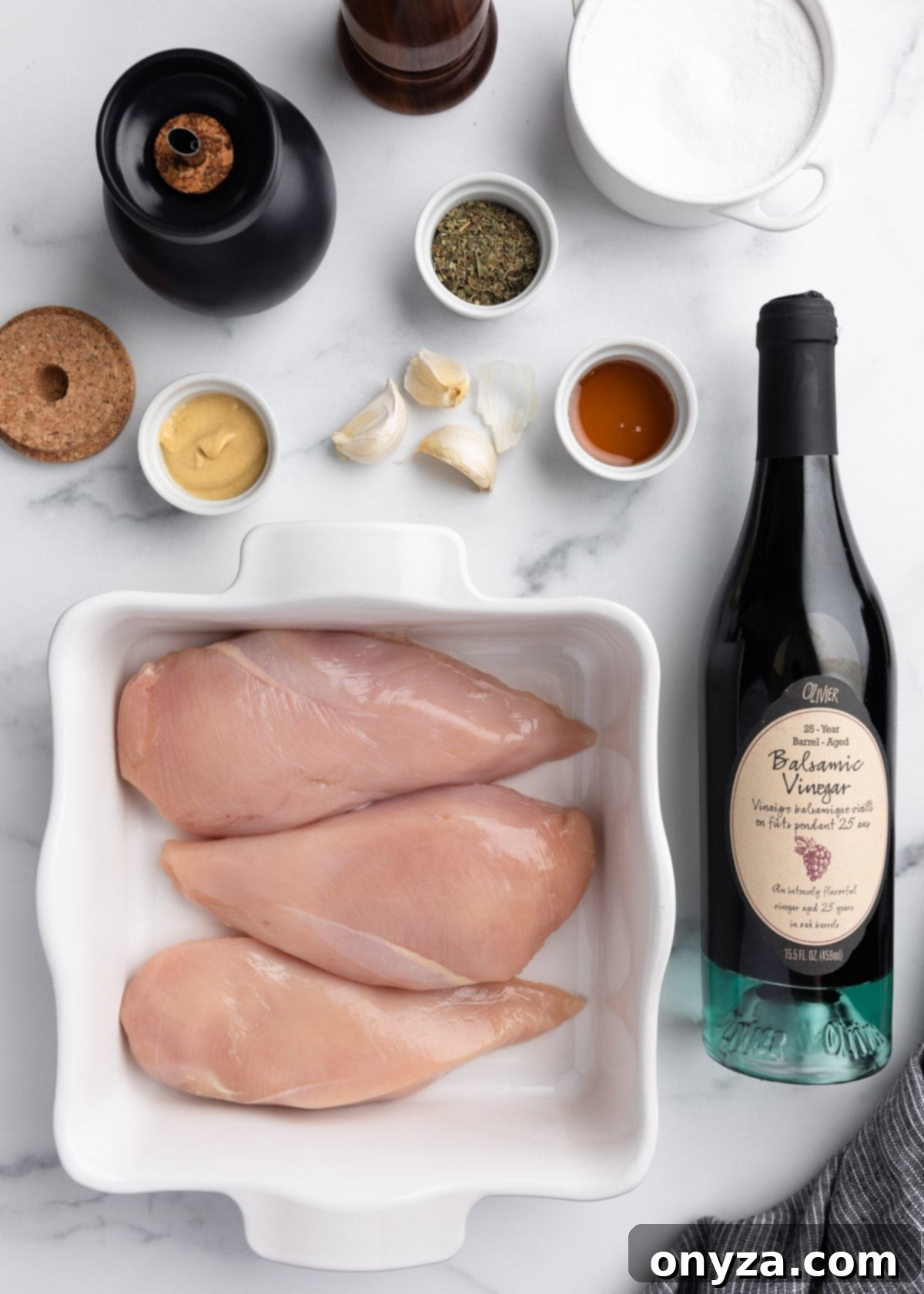
Crafting the Perfect Balsamic Chicken Marinade: Key Ingredients and Their Roles
Creating an exceptional marinade starts with high-quality ingredients that balance and complement each other. This balsamic chicken marinade is a harmonious blend of tangy, sweet, savory, and aromatic elements, each playing a crucial role in tenderizing the chicken and imparting incredible flavor. Here’s a closer look at what you’ll need and why:
- Balsamic Vinegar: This is the star of our marinade, providing its signature tangy and slightly sweet profile. While quality balsamic vinegar is a delight on its own, for a marinade that will be discarded after use, there’s no need to splurge on an expensive, aged bottle. A good commercial-grade or condiment-grade balsamic works perfectly. It will deliver the essential acidity needed for tenderizing the chicken and infuse it with rich, deep flavor without breaking the bank.
- Fresh Garlic: Garlic is indispensable in almost any savory marinade. I recommend using about 3 cloves, or roughly 2 teaspoons, finely minced. Fresh garlic provides a pungent, aromatic depth that dried garlic simply cannot replicate. It’s a foundational flavor that pairs beautifully with the balsamic and herbs.
- Dijon Mustard: More than just a condiment, Dijon mustard adds another layer of acidity and a subtle, sophisticated spice to the marinade. It also acts as an emulsifier, helping to bind the oil and vinegar together, ensuring a more uniform coating for your chicken. Its sharp, tangy notes cut through the richness of the chicken, enhancing the overall flavor profile.
- Honey: To balance the tangy and acidic notes of the balsamic vinegar and Dijon mustard, honey brings a touch of natural sweetness. This sweetness is vital not only for flavor but also for encouraging beautiful caramelization during cooking, creating those desirable browned edges on your chicken. Maple syrup or brown sugar can be suitable alternatives if you prefer.
- Dried Italian Herbs (“Italian Seasoning”): A good blend of Italian herbs is key to an authentic Mediterranean flavor. My favorite blends typically include oregano, basil, marjoram, and rosemary. These herbs offer an aromatic, earthy dimension that rounds out the marinade beautifully. Feel free to use your preferred brand or even create your own mix with individual dried herbs.
- Kosher Salt and Freshly-Ground Black Pepper: These essential seasonings elevate all the other flavors. Salt tenderizes the chicken further and enhances its natural taste, while freshly ground black pepper adds a hint of warmth and mild spice. Always season to taste, but start with the recommended amounts for a balanced flavor.
*Shopping for balsamic? For more details on Grades of Balsamic Vinegar refer to The Spruce Eats.
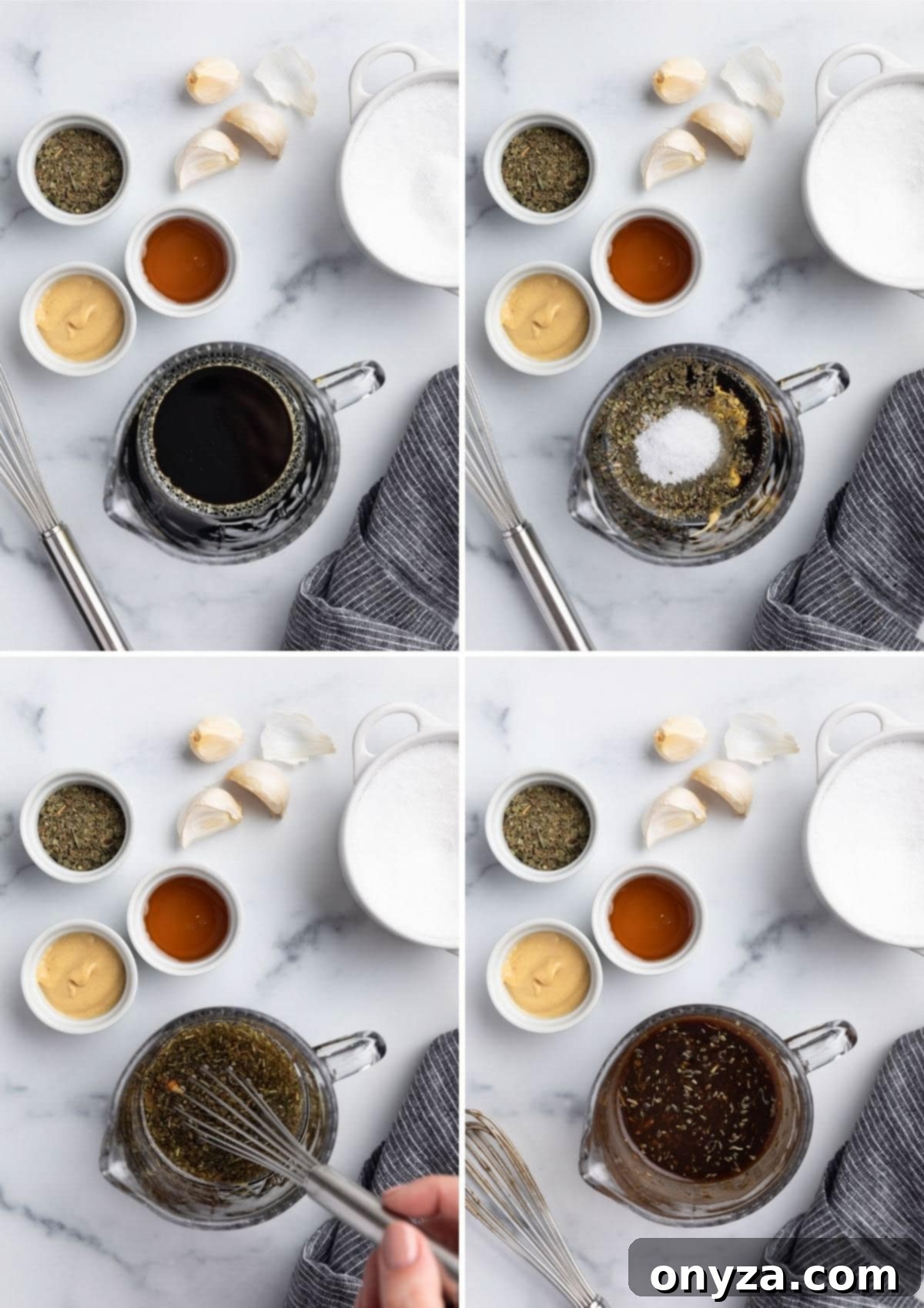
Step-by-Step Guide to Making Balsamic Marinated Chicken
The process of making this flavorful balsamic chicken is surprisingly straightforward, broken down into a few simple steps that ensure maximum flavor and optimal texture. From preparing the chicken to mastering the marinating time, each stage contributes to the final delicious outcome.
Preparing the Marinade: Quick & Easy
Making the marinade itself couldn’t be simpler. In a medium bowl or a liquid measuring cup, combine all the listed ingredients: olive oil, balsamic vinegar, minced garlic, Dijon mustard, honey, Italian herbs, kosher salt, and freshly-ground black pepper. Whisk everything together thoroughly until well combined. The mixture will have a relatively thick consistency, yet remain easily pourable. This concentrated blend of flavors is what will transform your plain chicken into a culinary delight.
Prepping Your Chicken for Success
For this balsamic marinade, I highly recommend using boneless, skinless chicken breasts. This recipe is perfectly suited for about 1-1/2 pounds of chicken, typically 3 to 4 breasts, each weighing approximately 6 to 8 ounces. On occasion, I’ve also successfully used larger breasts, ranging from 10 to 12 ounces, by simply adjusting the marinating and cooking times slightly.
A crucial step for ensuring evenly cooked, juicy chicken is to address any variations in breast thickness. Before you even think about marinating, take a moment to examine your chicken breasts. If some are significantly thicker than others, use a meat pounder or the flat side of a heavy pan to gently pound them to a more uniform thickness. This simple technique guarantees that all pieces cook at the same rate, preventing thinner sections from drying out while thicker parts are still reaching their safe internal temperature. To pound chicken breasts, I typically place them in an unsealed zip-top bag or between two sheets of plastic wrap for easy cleanup and to prevent splattering.
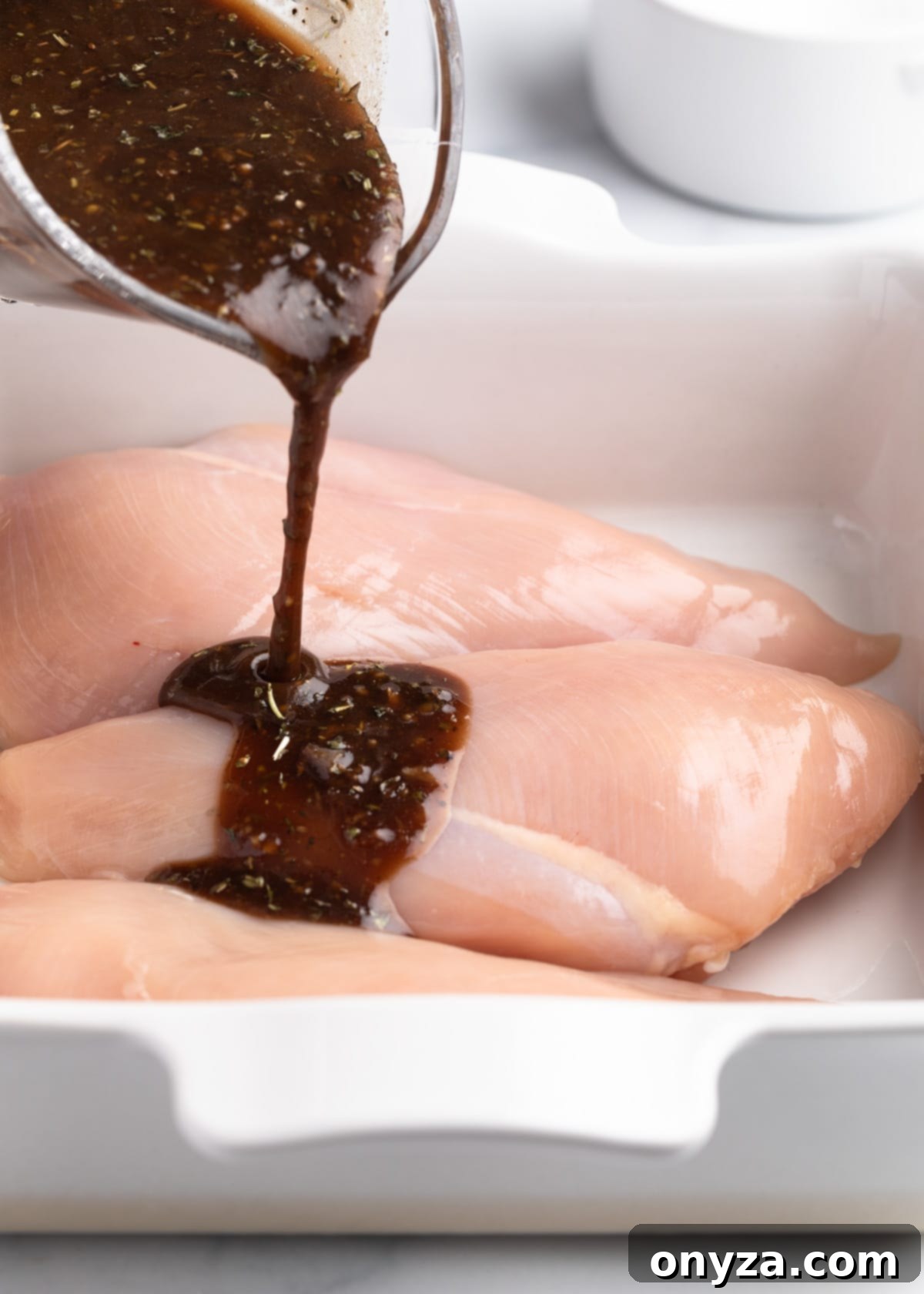
Optimal Marinating Techniques for Flavor and Safety
Once your chicken is prepped, it’s time for the marinade to work its magic. While I’ve occasionally used a shallow, non-reactive baking dish for photographic purposes (arranging the breasts in a single layer and pouring the marinade over, turning to coat), my preferred method for convenience and hygiene is a disposable zip-top bag.
Simply place the chicken breasts into the zip-top bag, then pour in the prepared marinade. Before sealing the bag, gently press out any excess air. This ensures that the marinade has maximum contact with the chicken. Once sealed, lightly massage the chicken from the outside of the bag to make sure every piece is thoroughly coated. This method not only provides excellent coverage but also makes cleanup incredibly easy.
The Science of Marinating: How Long is Just Right?
For the absolute best flavor and tender texture, balsamic chicken should marinate in the refrigerator for a period ranging from 1 to 8 hours. If you’re using a pan, make sure it’s covered tightly with plastic wrap to prevent cross-contamination. The ideal marinating time can vary slightly depending on the thickness of your chicken. Thinner cuts, like chicken cutlets, will require less time than whole, thicker breast pieces. I have pushed this marinade up to 12 hours (overnight) on particularly busy days, especially with larger chicken breasts, but I generally wouldn’t recommend exceeding that duration.
It’s important to understand that when it comes to marinating, more isn’t always better, especially with acid-based marinades like this one. Marinades containing acids, such as vinegar or lemon juice, work by breaking down the protein fibers in the meat. While this initial breakdown tenderizes the chicken and allows flavors to penetrate, prolonged exposure can actually have adverse effects on the meat’s texture. If left too long, the chicken can become rubbery and tough, or in some cases, surprisingly mushy and mealy.
To ensure you achieve perfectly juicy and tender chicken with a robust flavor, adhere to the recommended 1 to 8-hour window. For exceptionally large cuts, you can extend it up to 12 hours (overnight) if necessary. This timeframe will guarantee that the chicken absorbs ample flavor without compromising its desirable texture. Always remember to keep the chicken refrigerated during the entire marinating process for food safety.

Cooking Your Balsamic Marinated Chicken Breasts: Grill, Bake, or Air Fry
One of the many advantages of this balsamic marinated chicken is its versatility in cooking methods. While grilling imparts a wonderful smoky char, you can also achieve fantastic results by baking it on a sheet pan or air frying it. Regardless of your chosen method, a key consideration is the sugar content in the balsamic vinegar and honey. These sugars can caramelize quickly and potentially burn if the heat source is too high, similar to a teriyaki sauce. To avoid any unwanted charring, ensure your cooking temperature is not excessively high, allowing the chicken to cook through before the marinade has a chance to burn.
Before you begin cooking, remove the chicken breasts from the marinade and allow any excess to drip off. It is crucial to discard any leftover marinade in the bowl or bag. This marinade has been in contact with raw chicken and should never be reused or served with the cooked chicken unless it has been boiled vigorously for several minutes to eliminate bacteria.
For all cooking methods, the most reliable way to determine doneness is by using an instant-read meat thermometer. The chicken should reach an internal temperature of 165 degrees F (74 degrees C) at its thickest part. After cooking, transfer the chicken to a platter, tent it loosely with foil, and let it rest for 5 to 10 minutes. This resting period is vital, as it allows the juices to redistribute throughout the meat, resulting in a more tender and moist finished product. During this time, the internal temperature will continue to rise slightly, often reaching around 170 degrees F (77 degrees C).
Note that cooking times are approximate and will vary significantly based on the size and thickness of the chicken breasts you are cooking, as well as the specific appliance you are using. Always rely on an internal thermometer to gauge doneness, rather than strictly adhering to time estimates.
Need a reliable instant-read thermometer? I highly recommend the Thermapen ONE {affiliate link} from Thermoworks. It’s renowned for its speed, accuracy, and easy-to-read display, making it effortless to ensure perfectly-cooked chicken breasts every single time.
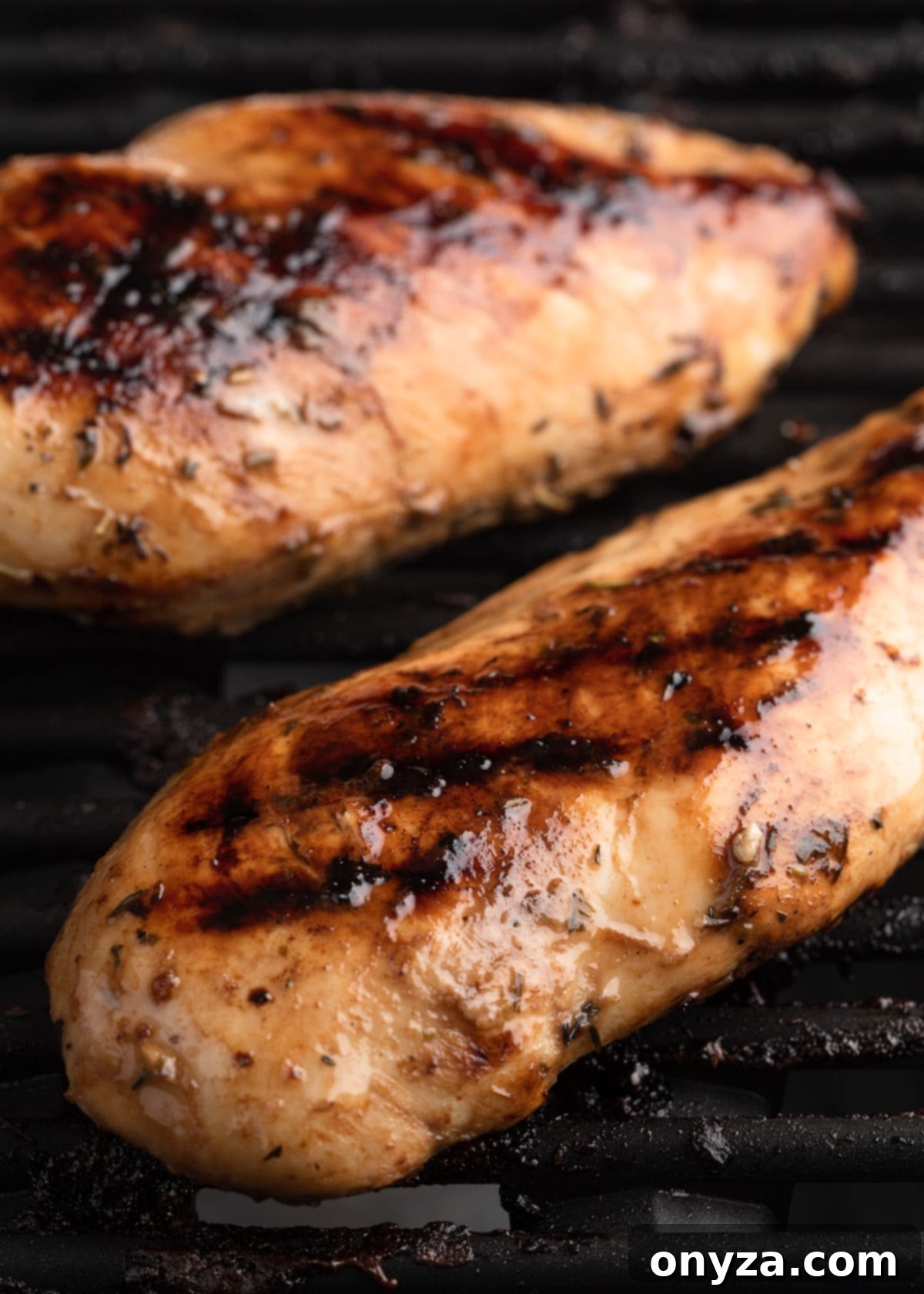
Grilling for Smokey Perfection
To grill your balsamic chicken, preheat your grill to a medium-high heat, aiming for a temperature between 375 to 400 degrees F (190-205 degrees C). Lightly oil the grates to prevent sticking. Place the chicken breasts on the direct heat and grill for approximately 6-8 minutes per side. Remember that these times are estimates and will depend on the thickness of your chicken. Cook until the internal temperature reaches 165 degrees F (74 degrees C).
For larger chicken breasts, a great technique is to first sear them over direct heat to achieve beautiful grill marks and caramelization. Then, move them to indirect heat, closing the grill lid, to allow them to cook through completely. This method helps prevent the marinade from charring excessively while ensuring the chicken cooks evenly without drying out. Once cooked, transfer to a platter, tent with foil, and rest before slicing and serving.
Baking in the Oven or Air Frying for Easy Weeknights
To bake: Preheat your oven to 400 degrees F (200 degrees C). Since the marinade contains sugars that will caramelize and potentially stick, I highly recommend lining a rimmed baking sheet with foil for effortless cleanup. Lightly oil the foil (a quick spray with cooking spray works well) before arranging the chicken breasts in a single layer. For 6 to 8-ounce breasts, start checking the temperature after 20-25 minutes. Larger 10-12 ounce breasts will typically require closer to 30-35 minutes. Always cook until the internal temperature reaches 165 degrees F (74 degrees C). Remove from the oven, tent with foil, and rest for 5-10 minutes.
To air fry: Preheat your air fryer to 360 degrees F (180 degrees C) and lightly spray the basket with cooking spray. When air frying, it’s particularly important to ensure you’ve allowed as much excess marinade as possible to drip off the chicken. This minimizes drippage into the air fryer base, making cleanup easier and reducing the chance of smoke. Air fry the chicken breasts for 15-22 minutes, flipping them halfway through the cooking time to ensure even browning. Keep in mind that air fryer cooking times can vary significantly by brand and model, so pay close attention to your first batch to accurately gauge the cooking times for your specific appliance. Cook until the internal temperature reaches 165 degrees F (74 degrees C). Rest the chicken, tented with foil, for 5-10 minutes before serving.

What to Serve with Balsamic Marinated Chicken
The robust and versatile flavor of balsamic marinated chicken makes it an excellent centerpiece for a variety of meals. I particularly love using this marinade to prepare grilled chicken breasts for a Grilled Balsamic Chicken Salad, where the tender chicken pairs beautifully with fresh greens and other vibrant ingredients. If you’re serving the chicken as a main dish, several side options will complement its rich flavor profile.
Consider pairing it with fresh, crisp salads such as my Arugula and Fennel Salad for a peppery crunch, or a refreshing Orzo Salad with Feta that offers bright, Mediterranean notes. For a taste of summer, an Heirloom Tomato Salad with its sweet and juicy tomatoes would be an exquisite match. Beyond salads, this chicken pairs wonderfully with classics like fluffy Rice Pilaf, a creamy Caprese Pasta Salad, hearty roasted potatoes, or a medley of grilled vegetables. A simple side salad, dressed with a bright Homemade Balsamic Vinaigrette, is always a fantastic choice to complete the meal.
Explore More Delicious Chicken Breast Recipes
If you’ve enjoyed the simplicity and flavor of this balsamic marinated chicken, you might be interested in exploring other exciting ways to prepare chicken breasts. Here are some of my other favorite recipes that offer diverse flavors and cooking techniques, perfect for expanding your culinary repertoire:
- Chicken Milanese: A crispy, pan-fried delight often served with lemon.
- Chicken Marsala: Tender chicken cutlets in a rich mushroom and Marsala wine sauce.
- Cranberry Chicken Salad with Walnuts: A refreshing and hearty salad perfect for sandwiches or light lunches.
- Mandarin Orange Chicken Salad: A vibrant, Asian-inspired salad with a delightful sweet and savory dressing.
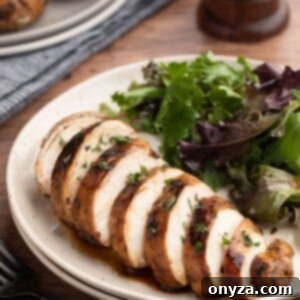
Balsamic Marinated Chicken
This simple balsamic and herb marinade is a straightforward way to elevate your weeknight chicken dinner rotation. It’s easy to prep ahead, resulting in juicy, tender, and full-of-flavor chicken every time!
Ingredients
- 1-1/2 pounds boneless, skinless chicken breasts *
- ¼ cup olive oil **
- ¼ cup balsamic vinegar
- 3 large garlic cloves, minced (about 2 teaspoons)
- 2 teaspoons Dijon mustard
- 2 teaspoons honey
- 2 teaspoons dried Italian herbs (Italian seasoning)
- 1 teaspoon kosher salt
- ½ teaspoon freshly-ground black pepper
Instructions
- In a measuring cup or bowl, whisk together olive oil, balsamic vinegar, garlic, Dijon, honey, herbs, salt, and pepper until well combined.
- Place chicken in a single layer in a non-reactive baking dish, bowl, or disposable zip-top bag. Pour marinade over the chicken, ensuring all pieces are thoroughly coated. If using a bowl or pan, cover with plastic wrap. If using a zip-top bag, press out the air and seal tightly.
- Refrigerate and allow the chicken to marinate for 1 to 8 hours, turning the breasts in the marinade occasionally to ensure even flavor distribution. When ready to cook, remove the chicken from the marinade, letting any excess drip off. Discard the leftover marinade.
To Grill
- Pre-heat the grill to 375 to 400 degrees F (190-205°C) and lightly oil the grates to prevent sticking. Grill over direct heat for about 6-8 minutes per side, or until the chicken reaches an internal temperature of 165 degrees F (74°C) in the thickest part of the breast. Cooking time will vary by breast thickness.
- For larger chicken breasts, sear them over direct heat first, then move them to indirect heat and cover the grill to finish cooking through. This technique helps prevent the marinade from over-charring.
- Transfer the cooked chicken to a platter and tent loosely with foil. Let rest for 5-10 minutes before slicing and serving.
To Bake
- Preheat the oven to 400 degrees F (200°C). Line a rimmed baking sheet with foil and lightly oil it or spray with cooking spray for easy cleanup. Arrange the chicken breasts in a single layer.
- Bake for 20-25 minutes for 6 to 8-ounce breasts, or 30-35 minutes for 10-12 ounce breasts, until the chicken reaches an internal temperature of 165 degrees F (74°C) in the thickest part of the breast.
- Remove from the oven, tent with foil, and let rest for 5-10 minutes before serving.
To Air-Fry
- Preheat the air fryer to 360 degrees F (180°C) and spray the basket with cooking spray. For easier cleanup, ensure you’ve allowed any excess marinade to drip away from the breasts before placing them in the air fryer.
- Air fry the chicken for 15-22 minutes, turning them over halfway through the cooking time for even crisping. The chicken is done when it reads 165 degrees F (74°C) in the thickest part of the breast. Rest the chicken for 5-10 minutes, tented with foil, and serve.***
Notes
*If there’s a significant difference in the thickness of the chicken breasts, gently pound them to an even thickness for consistent cooking results. Use the flat side of a meat mallet or a rolling pin, and pound the chicken between two pieces of plastic wrap or inside an open zip-top bag. The goal is not to create thin cutlets, so for best results, avoid pounding the breasts thinner than 3/4 to 1 inch.
**I use regular olive oil rather than extra virgin olive oil for this marinade because it has a slightly higher smoke point, which is especially beneficial when grilling the chicken.
***Air fryer cooking times can vary considerably depending on the specific model and brand. I recommend closely monitoring your first batch of chicken to accurately determine the ideal cooking times for your particular air fryer.
Nutrition estimate is based on a 6 ounce breast with 10% marinade absorption.
Nutrition Estimate
Nutrition information is automatically calculated, so should only be used as an approximation.
Please note that our recipes have been developed using the US Customary measurement system and have not been tested for high altitude/elevation cooking and baking.
